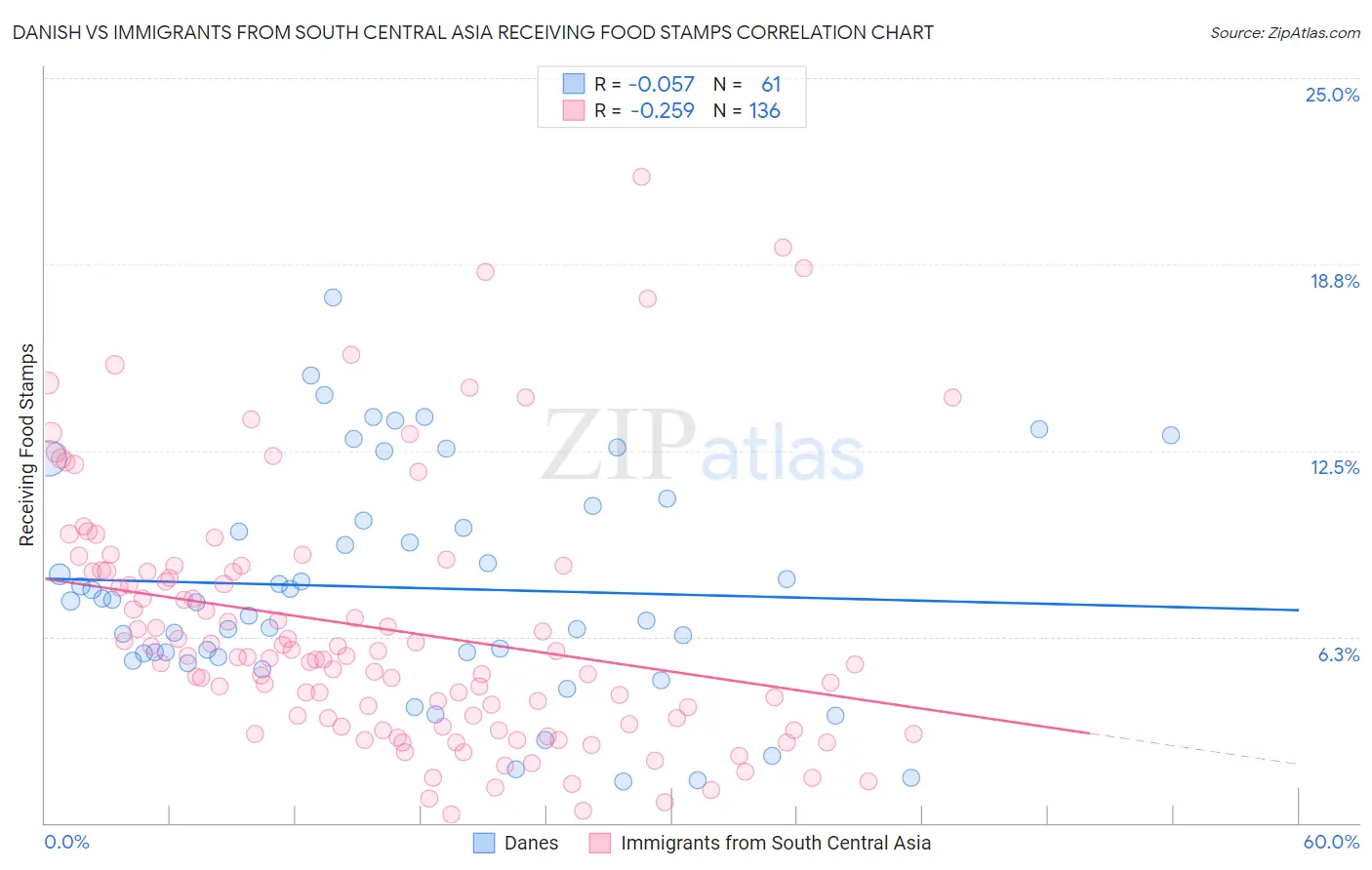Danish vs Immigrants from South Central Asia Receiving Food Stamps
COMPARE
Danish
Immigrants from South Central Asia
Receiving Food Stamps
Receiving Food Stamps Comparison
Danes
Immigrants from South Central Asia
9.0%
RECEIVING FOOD STAMPS
99.9/ 100
METRIC RATING
18th/ 347
METRIC RANK
8.8%
RECEIVING FOOD STAMPS
99.9/ 100
METRIC RATING
10th/ 347
METRIC RANK
Danish vs Immigrants from South Central Asia Receiving Food Stamps Correlation Chart
The statistical analysis conducted on geographies consisting of 472,155,016 people shows a slight negative correlation between the proportion of Danes and percentage of population receiving government assistance and/or food stamps in the United States with a correlation coefficient (R) of -0.057 and weighted average of 9.0%. Similarly, the statistical analysis conducted on geographies consisting of 471,034,048 people shows a weak negative correlation between the proportion of Immigrants from South Central Asia and percentage of population receiving government assistance and/or food stamps in the United States with a correlation coefficient (R) of -0.259 and weighted average of 8.8%, a difference of 2.3%.

Receiving Food Stamps Correlation Summary
| Measurement | Danish | Immigrants from South Central Asia |
| Minimum | 1.4% | 0.30% |
| Maximum | 17.7% | 21.7% |
| Range | 16.3% | 21.4% |
| Mean | 7.9% | 6.5% |
| Median | 7.4% | 5.6% |
| Interquartile 25% (IQ1) | 5.6% | 3.3% |
| Interquartile 75% (IQ3) | 10.4% | 8.5% |
| Interquartile Range (IQR) | 4.8% | 5.2% |
| Standard Deviation (Sample) | 3.7% | 4.3% |
| Standard Deviation (Population) | 3.7% | 4.3% |
Demographics Similar to Danes and Immigrants from South Central Asia by Receiving Food Stamps
In terms of receiving food stamps, the demographic groups most similar to Danes are Immigrants from Scotland (9.0%, a difference of 0.45%), Immigrants from Hong Kong (9.1%, a difference of 0.58%), Immigrants from Japan (9.0%, a difference of 0.61%), Norwegian (9.0%, a difference of 0.88%), and Latvian (9.1%, a difference of 0.91%). Similarly, the demographic groups most similar to Immigrants from South Central Asia are Okinawan (8.9%, a difference of 0.43%), Cypriot (8.9%, a difference of 0.44%), Bulgarian (8.9%, a difference of 0.63%), Maltese (8.9%, a difference of 0.77%), and Norwegian (9.0%, a difference of 1.4%).
| Demographics | Rating | Rank | Receiving Food Stamps |
| Iranians | 100.0 /100 | #4 | Exceptional 7.9% |
| Thais | 100.0 /100 | #5 | Exceptional 8.1% |
| Immigrants | Singapore | 100.0 /100 | #6 | Exceptional 8.3% |
| Immigrants | Iran | 100.0 /100 | #7 | Exceptional 8.3% |
| Burmese | 99.9 /100 | #8 | Exceptional 8.6% |
| Immigrants | Korea | 99.9 /100 | #9 | Exceptional 8.7% |
| Immigrants | South Central Asia | 99.9 /100 | #10 | Exceptional 8.8% |
| Okinawans | 99.9 /100 | #11 | Exceptional 8.9% |
| Cypriots | 99.9 /100 | #12 | Exceptional 8.9% |
| Bulgarians | 99.9 /100 | #13 | Exceptional 8.9% |
| Maltese | 99.9 /100 | #14 | Exceptional 8.9% |
| Norwegians | 99.9 /100 | #15 | Exceptional 9.0% |
| Immigrants | Japan | 99.9 /100 | #16 | Exceptional 9.0% |
| Immigrants | Scotland | 99.9 /100 | #17 | Exceptional 9.0% |
| Danes | 99.9 /100 | #18 | Exceptional 9.0% |
| Immigrants | Hong Kong | 99.8 /100 | #19 | Exceptional 9.1% |
| Latvians | 99.8 /100 | #20 | Exceptional 9.1% |
| Luxembourgers | 99.8 /100 | #21 | Exceptional 9.1% |
| Immigrants | Australia | 99.8 /100 | #22 | Exceptional 9.2% |
| Eastern Europeans | 99.8 /100 | #23 | Exceptional 9.2% |
| Immigrants | Northern Europe | 99.8 /100 | #24 | Exceptional 9.2% |